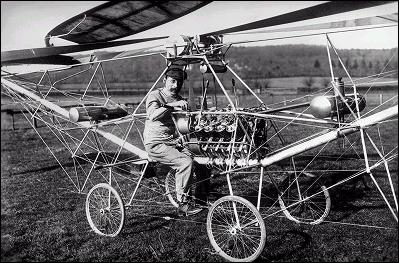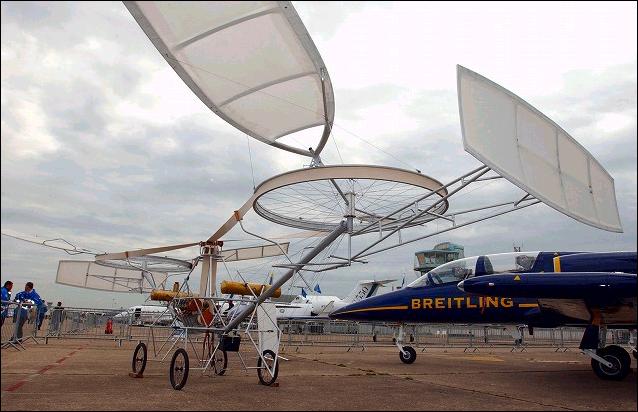<Straight Up>
100 Years
since the First Flight of Helicopter

It was now been 100 years since the world's first manned-helicopter flight took place in France, with Paul Cornu successfully taking to the air on November 13, 1907. After boarding his helicopter, Cornu tried several times to lift off, after finally reaching an altitude of 1.8 meters-yes, 1.8 meters-for about 20 seconds. This aviation milestone paved the way for a new type of aircraft, and this date should not be forgotten by anyone who enjoys or depends on the benefits of rotary-wing flight.
Though there are only old, low-quality photos of Cornu's first helicopter, I was very pleased that a replica of the helicopter would be displayed the Paris Air Show this year. Sadly, though, the helicopter had been removed from Le Bourget International Airport before I was able to see the replica of the historical aircraft.
The significance of Cornu's helicopter flight is comparable with the Wright brothers' first flight in 1903, but there are many people who question if Cornu's short hover can be regarded as a true flight. Those same skeptics maintain that Wright brothers' Flyer maintained stability and maneuverability throughout its maiden flight, while Cornu's helicopter was unstable and almost out of control.
This lack of control was most likely due to the engine's output of 24 HP was not being enough to lift the 260-kg airframe, a power to weight ratio of 1 HP per 11 kg. People suspect that someone witnessing the first flight might acknowledge that the helicopter flew when its one of its wheels lifted off the ground or that it weakly flew for 30 cm as the inertia from its rotors moved it laterally. Unfortunately there were no official witnesses or photos of the first flight.
Fast forward 40 years and we saw the Sikorsky and Bell 47 helicopters in practical use, with a 1 HP for each 5.5 kg of weight. Compare that to today's BK117s and EC135s, which have 1 HP for reach 2.2 to 2.3 kg of weight, and the high-speed A109s with 1 HP for every 1.9 kg of weight, and we can see just how far helicopters have progressed.
Considering the possibility of engine failure, the Wright Flyer could have glided to a safe landing without power. Conversely, Cornu's helicopter would surely have crashed after an engine failure, certainly not having autorotation landing capability. It would take another 30 years for autorotation landing capabilities to be realized.
Back in the the 1880s, the bicycle was the most advanced and fastest type of vehicle, so it is no surprise that both Paul Cornu and Wright brothers were bicycle makers and engineers. In those times, the bicycle fascinated many in the younger generation, and mechanically-minded people became very involved in making technological improvements to the bicycle.
The bicycle eventually progressed to the development of the car, though a few engineers had the ingenuity and perseverance to use bicycle technology for aircraft. Paul Cornue and Wright brothers must have been amongst those pioneers.
I have not seen Cornu's helicopter, except in photos, but to me it looks like a flying bicycle, and something I can closely relate to.
printed in Japan Aviation Weekly of September 10, 2007)

Photo (courtesy of Eurocopter): Replica of Paul Cornu's helicopter displayed at the 47th Paris Air Show, at Le Bourget Airport, 2007. The replica was built by engineers at the ESTACA School, a French aerospace engineering school.
上の英文は、日本航空新聞社の週刊英字紙に掲載されたもので、山野豊氏に翻訳していただいた.。念のために要旨は下の通りである。
ヘリコプター初飛行百年
今年は、人を乗せたヘリコプターが初めて飛んでから百年になる。その飛行に成功したのは、フランス人ポール・コルニュであった。1907年11月13日、コルニュ自ら乗りこんで何度か離昇を試みた結果、地上1.8mほどのところで20秒ほどとどまることができた。これが史上初のヘリコプターの飛行とされる。ヘリコプター人にとっては、忘れてはならない日付といえよう。
このヘリコプター初号機を、私は昔のぼんやりした写真でしか見たことがない。それが今年、百年目を記念してパリ航空ショーでレプリカが展示されるというので楽しみにしていた。ところがショーに行ったのが後半だったため、早くも片づけられてしまったらしく、残念ながら見ることはできなかった。
ポール・コルニュの飛行はヘリコプターとして1903年のライト兄弟の初飛行にもたとえられるが、真の飛行といえるかどうか疑問を呈する人も多い。ライト・フライヤーには安定性も操縦性もあったが、コルニュ機はホバリング中も安定せず、操縦性は不充分、もしくは皆無だったというのである。
さらに機体の重量に対してエンジン出力が不足気味であることも問題で、コルニュ機は総重量260kgで出力24馬力だった。1馬力あたりの重量は11kgに近く、これでは片足だけ持ち上がったのを飛んだと思ったか、ローター回転の慣性でふらふらと30センチほど浮き上がっただけか、公式の立会人もいなければ写真もないので、本当のところは曖昧だというのである。
確かに、それから40年後、初めて実用化されたシコルスキーS-51やベル47は1馬力当り5.5kg以下であった。現代のBK117やEC135は2.2〜2.3kgだし、高速を誇るA109などは1.9kgである。
さらにエンジンが止まったときはどうなるのか。ライト機ならば滑空できたであろう。しかしコルニュ機は滑空すなわちオートローテイションなどできなかったはずで、こうした技術的な課題が解消するまでには、その後30年以上待たねばならなかった。
ただし、ここで私が面白いと思うのは、ライト兄弟もポール・コルニュも自転車屋さんだったことである。自転車は1880年代では最新かつ最速の乗り物だった。多くの若者が自転車にあこがれ、機械好きの人はその改良に熱中した。そこから自動車への発展が始まり、ごく一部の人は自転車の技術を使って空を飛べるのではないかと考えた。それがライト兄弟でありポール・コルニュではなかったのか。
コルニュ機は、今も写真でしか見ていないが、まるで「空飛ぶ自転車」のようにも見えて親しみを覚えるのである。
パリ航空ショーに展示されたポール・コルニュ機のレプリカ。製作はESTACA Engineering Schoolの学生たち。(写真提供:ユーロコプター社)
(西川 渉、2007.9.17)
